Despite my enjoyment, I didn’t think doing puppet shows was enough of an acting career. So I only played in them intermittently, able to turn down roles, or step in when needed, less as a career, more as a source of income for more than five years.
I still went to open calls. One was when Screen Gems was looking for supporting actors to appear in a 1961 episode of Route 66 to be shot in Philadelphia.
I joined a roomful of young guys sitting anxiously, quietly, in a waiting room, hoping our faces, our résumés would impress the people casting. A new guy, looking younger than I, walked in bubbling with charm and vitality, accompanied by his agent. That part of the room lit up as if he were a star and the rest of us were somewhere in the empty darkness.
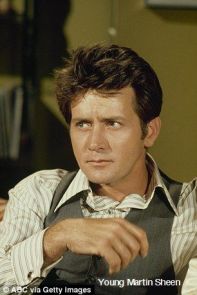
I didn’t get a role. No one I knew got a role either. That guy did, though. A good role. That made sense, based on how much personality he brought into that waiting room. He was Martin Sheen. He appeared in an episode airing in December that year. A big fan of the show, I just happened to be watching it.
Clearly I wasn’t developing as an actor. I needed to be in something challenging. Since nothing like that was coming. I decided to take acting lessons to keep in practice.
I applied at Hagen-Berghof Studio, a well-known incubator of talent, with a teaching staff including Broadway stars Uta Hagen and Herbert Berghof, William Hickey, Charles Nelson Reilly, and Earle Hyman. I had to audition for Hagen in order to get in. She didn’t intimidate me. She didn’t try to. My audition was part of the Balcony Scene from Romeo and Juliet that I’d retained and loved since my days at Temple playing Romeo on WFIL-TV.
Hagen warmly accepted me into her orbit, suggesting I study with Earle Hyman. Hyman had major Broadway and British credits.
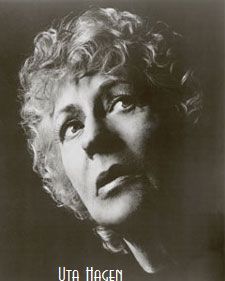
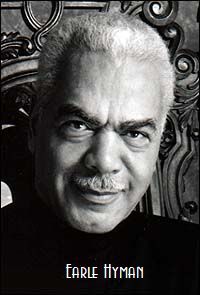
On the floor below our class Reilly was conducting one in musical comedy performing. Laughter from down there regularly bounced up to us. But then, Reilly was a stitch himself on stage.
For one of my class scenes with Earle I chose Edgar Allan Poe’s The Telltale Heart. After playing the madman with what I considered the right kind of dark, intense craziness, Earle kindly told me that it might work better if the narrator acted less crazy, as if believing himself sane, which would underscore his craziness. Good advice. Advice also valid when playing a drunk, suggesting the drunk doesn’t know he’s drunk.
In March 1962, I got another off-Broadway role, certainly not major, at One Sheridan Square in Greenwich Village in a one-act by often-absurdist Belgian playwright Michel de Ghelderode, The Women at the Tomb, translated by George Hauger. It was paired with another one-act, Philoctetes, by Mark Schoenberg, a re-working of a play by Sophocles about a legendary ancient Greek hero. Clearly, this was an esoteric double bill. I was delighted, of course, to be cast, even though in a small role.
Our play was originally conceived for marionettes (not that my work for Nicolo had any bearing on my being cast), a kind of comment suggesting that the characters are manipulated by fate and by history, no longer ordinary human beings.
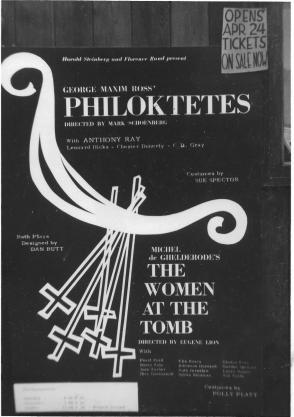
In it, 11 women share their thoughts about Christ when brought together after the Crucifixion. Mary, Christ’s mother, is there with another son, John (my role). De Ghelderode mocks many of these people. Most are not nice. This modern-dress, modern-language English version by George Hauger was adult and blunt and included profanity, not all that common on stages in 1962. Frank Aston of the New York World Telegram and Sun (one of several attempts to meld New York’s daily newspapers) wrote that the script commented on such people with “harsh novelty.” He didn’t say anything about me. No other critic did either. We had a short run.
After we closed we were invited to stage one performance in Judson Memorial Church, a few blocks away. During that, a well-dressed, affluent-looking, middle-aged man rose from his pew and headed for the exit angrily yelling, “Not in God’s house!”
Our costumes were designed by Polly Platt who, a few years later, became a costume designer and collaborator on films directed by Peter Bogdanovich, her husband. After that, she went on to an even more significant film career as co-producer of other movies.
Having a beard again was still rare enough that it seemed that it could make me so visibly noticeable that more than one stranger on the street derided me as a beatnik, even when I was well-dressed. In fact, once a man emerged from a Times Square throng and grabbed my arm, pulling on my hand, and aggressively stuck a quarter in it, saying angrily, “Go get yourself a shave.”
Another actor making the rounds with me was Harry Parkins, provoking strangers into asking him if he were a girl because he had shoulder-length black hair. He was proud of it, combing it regularly while waiting for interviews, as if, in pushing it away from his face, he was pushing the fact into everyone else’s faces. But he also was a rare sight those days.
We both knew, as did most actors, that casting people usually responded to how we looked. They weren’t required to use imagination. Consequently, many of us went to auditions trying to be dressed for the parts when we had some idea of what the roles were.
So, no doubt, seeming a beatnik landed me a spot as Greenwich Village color, an extra in a 1962 General Electric Theater half-hour show called Acres and Pains, starring Walter Matthau and Anne Jackson. The evening it aired, just before it started, a CBS booth announcer said, “Stay Tuned for General Electric Theater with Ronald Reagan, Anne Jackson, and Walter Matt-TOO.” Clearly, Matthau hadn’t yet made a big enough name for himself. Reagan was still mostly known as an actor, being also a major public spokesman for GE and not yet very active politically. Acres and Pains turned out to be a pilot for a series that was never produced.
The day of the shooting in the Village, much of the cast, including Matthau, Jackson, and me, hung out in a studio set designed to look like the interior of an apartment. After everyone was told what would be shot that day, I was sent to West Charles Street along with a guy who actually had a small role, playing someone delivering take-out food to the apartment. Cameras rolling, he was the subject, I was in the background.
Vene and I eagerly awaited the telecast at home. But a couple of minutes before, I decided to go to the bathroom. After all, I expected that the show would start with Reagan talking, plus a commercial from GE, and that my face would turn up later.
Vene called to me, “Hurry up! It’s starting.”
“I’ll be right there!”
A minute later I walked into the living room.
“You missed it,” Vene said. The show had opened not with Reagan or a commercial but with the first scene. A tracking shot of the delivery guy on his errand. Passing me. I’ve never seen how it looked.
But I was quite visible in my next movie job, getting hit by a riding crop and having famously-breasted British actress Sabrina chuck me suggestively under my hairy chinny-chin-chin.
Bernie Styles was a casting agent who worked with lots of TV and movie producers supplying extras. He had my picture and résumé on file and that spring called me saying he needed a small crowd for a nightclub scene in a movie called Satan in High Heels, which was shooting in a club on West 57th Street. He also wanted to make certain that all of us looked sophisticated and well-dressed, so I should wear a good shirt, suit, and tie. The call was 8 a.m.
I joined the crush hour on the IRT 7th Avenue subway line heading into Manhattan from Brooklyn Heights, hoping that my tie wouldn’t wrinkle too much and that my freshly polished shoes would not get too scuffed.
The set was an actual room in the club. It was suffused with cigarette smoke and bright lights from every nook and cranny. I was assigned a seat at a table in the club, sitting next to a woman I’d never met and would never encounter again. We were part of the hordes of extras all hoping for big breaks, a few meager lines, some special business, maybe even actual roles.
During camera set-ups or when various scenes were rehearsed, the woman and I and other dressed-up human scenery were able to learn something of the plot. It was a sexploitation movie, i.e., sensuously suggestive but not explicit. After all, this was at the tail-end of the Eisenhower years, and JFK was just making his presence felt, publicly as well as privately.
Meg Myles, a statuesque, fine-looking woman around my age, but looking more mature, starred as a woman named Stacey in a story involving drugs, murder plots, lesbianism, betrayal, deception, and, just to keep it interesting, a few songs.
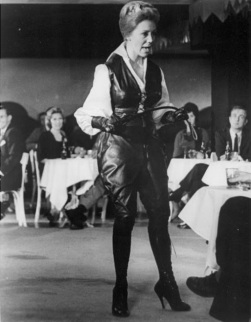
The nightclub was where Stacey was making her New York singing debut, dressed in a tight-fitting leather vest, leather riding pants, leather boots, and leather gloves, wielding a small riding crop. In this subtle outfit she strode the dance floor challenging us sophisticated, horny men with her open mouth and alluring tongue.
During this stroll, she occasionally slammed the crop on the pure white tablecloths. But once she missed and hit someone. Me. On one of my hands. “Cut!” the director yelled. “Sir?” he called from somewhere out in the club’s darkness behind the lights, “Are you alright?”
“Oh, sweetheart,” she crooned to me. “I’m so sorry” and caressed my wounded flesh on her impressive breasts.
I called back to the director, “I’m fine, thanks.” Right. I was more than fine. I had touched one of Meg Myles’s breasts. It was compensation enough.
Somewhere in those two days of shooting various parts of the nightclub scene, a British blonde movie star around Myles’s age and mine named solely Sabrina (born Norma Ann Sykes) became part of the act. Incidentally, despite similarities of age, I felt a lot younger and innocent.
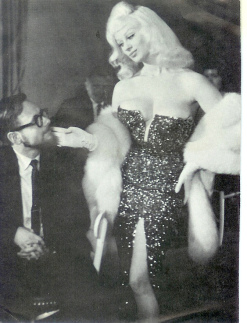
Sabrina was known widely for her superstructure. When she paused at my table, I didn’t get to touch her assets. But she touched me, caressing my face with one of her long white-gloved hands. What had she to do with the story? No idea. And, according to Wikipedia, she appeared in the movie without a character name, but rather as Sabrina.
For an extra I was certainly getting a lot of attention. But no extra money.
Oh, and I haven’t yet seen that production either. Now, though, with a copy at Netflix, who knows?
In the fall the movie emerged. I only accidentally learned about that. Vene and I and her visiting uncle Tony, a.k.a. “Junior,” up from sunny Florida, were walking along that stretch of 42nd Street which gave Times Square its reputation for sleaziness. The long block between Eighth and Seventh Avenue had perhaps as many as 10 movie theaters, almost all showing exploitation-type stuff or low-budget sensational crime films or generic Westerns, often as double-features. As we hurried by, Uncle Junior, wide-eyed and shocked, said “Gordie! Look that’s you!” as he pointed to a still photo posted outside one of the theaters. It was Sabrina and me. The feature was Satan in High Heels.
“Wow!” he exclaimed, “I didn’t know you were starring in a movie! That’s great!”
I tried to explain to him what it meant to be an extra. I decided not to disillusion him as to why my face was there, knowing full well that the reason was Sabrina’s potential wardrobe malfunction. Anyway, I was able to fend off his inquiries about the story in the film. I didn’t think he could deal with it, being a devout Catholic, a mamma’s boy, and not used to immersion, post-baptism, into the murky waters of sins of the flesh, fictional or real.
Bernie Styles called me with another job. I was to show up at 8 a.m. on West 56th Street between Eighth and Ninth Avenues for a movie starring Paul Newman, George C. Scott, Jackie Gleason, and Piper Laurie: The Hustler
Arriving at a police barricade, I was stopped by an officer but Bernie passed me in. He told me to join a bunch of people further down the street, sitting in folding chairs on a sidewalk next to what looked like the entrance to a night club with a narrow front awning.
The whole street was blocked off. There were trucks and spotlights everywhere. And in the street was a small railroad-like track with a large camera sitting on a movable platform at one end.
There was also a truck with an open side window where a man was handing out coffee and doughnuts to the crew and to any of us wanting them. And there were at least 20 of us extras.
Paul Newman was wearing a sports jacket and conversing with someone by the large camera. It was Piper Laurie.
I wasn’t near enough to hear what they were saying, but they were gesticulating as if running lines.
A man with a clipboard came over. “OK,” he said, pointing to three of us “I need you and you and you.” Not me. “Come on over to the club.”
At 9 a.m., it started to rain. Fake rain, coming from a small truck with a large tank on top, spraying the entire front of the club. Piper Laurie, holding an umbrella, stood under the awning, talking to Paul Newman while the three extras rushed by as if trying not to get wet.
This was shot from a lot of different angles.
Mr. Clipboard gathered five more of us. Not me. They peopled a scene in the rain with Paul Newman and Piper Laurie walking down the street, while the camera on tracks followed alongside them.
Lunch break. The coffee and doughnut truck served us sandwiches, chips, coffee, cookies.
While we were having lunch, George C. Scott showed up. He and Paul Newman shook hands and started talking to each other, having some good laughs.
The water truck had left the scene. And from what we extras could understand, the truck had broken down and another one would soon be on the way.
To pass the time George C. and Newman started passing a football up and down the empty spaces along the sidewalk nearest Ninth Avenue. At one point he caught the ball right in front of me. “Hey!” he said. “How are you doing?”
“Fine. Thanks,” I replied. A little too overawed for someone who was supposed to be a professional actor.
There were takes of George C. and Newman talking, standing in front of the same club, in different clothes, and without rain. But, although other extras represented passers-by, I was not among them.
By the end of the day, eight of us hadn’t done anything but sit on the chairs and talk, except when nearby dialogue was running.
Mr. Clipboard finally came over to us. “O.K. That’s it for now. Thank you all. We’re taking a dinner break. We may shoot some more stuff this evening, but I guess that’s it for you, huh?”
Bernie wasn’t there. After having walked away disappointed, I called him on a pay phone and told him that I didn’t get into any shots, asking him if I could stay for the evening if I could be used.
“Yeah, sure. Why not?” he answered.
The night scenes were like the day ones. Fake rain again. I was not in them.
Nonetheless in my résumé I put The Hustler as a credit. Well, after all, I had been hired to be in it. I got paid to be in it. Twice. I could legitimately say that I had worked on it.
You can hardly call being in those three productions significant acting. Maybe there could have been more work, Bernie Styles had casually told me, if I didn’t have the beard.